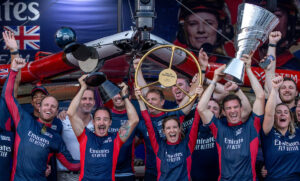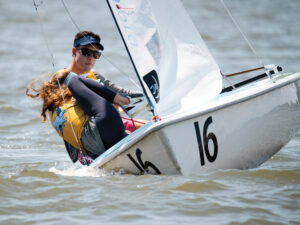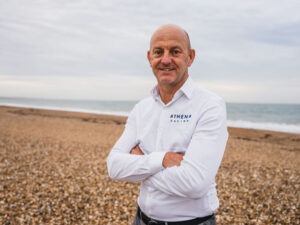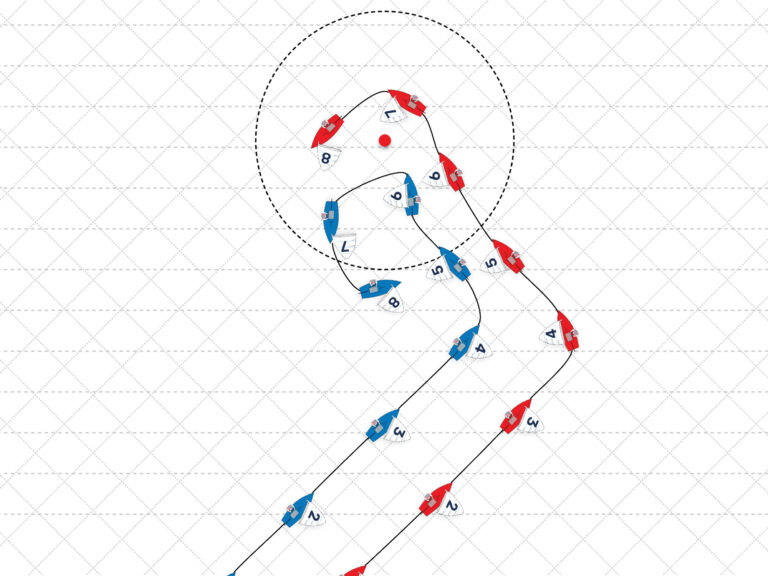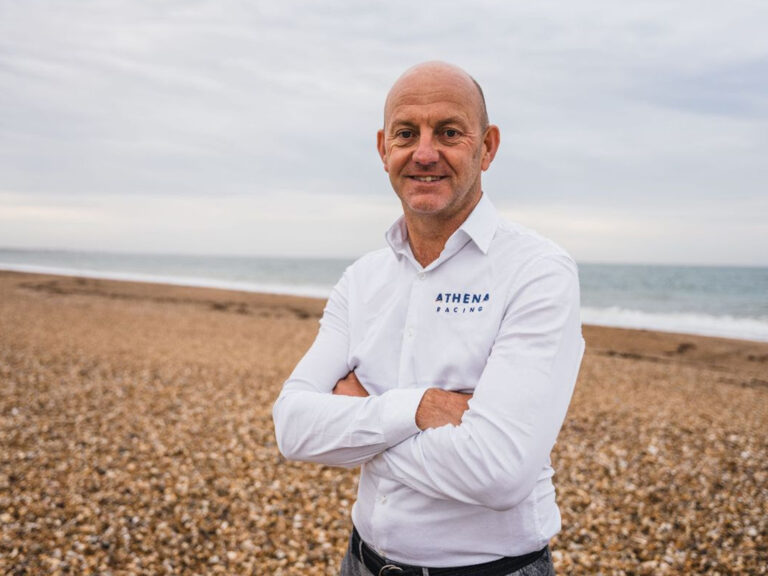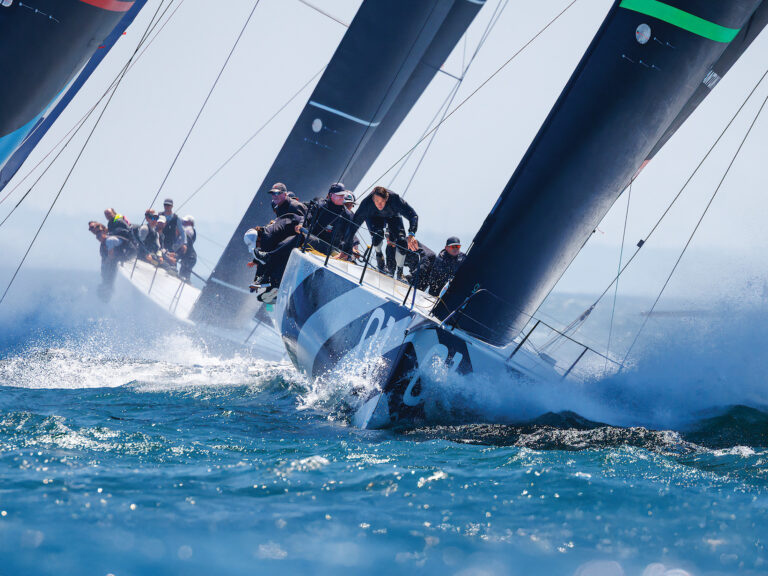Michel Desjoyeaux hopes to make history again as he attempts to take home the Route du Rhum trophy in the IMOCA class during the coming weeks after winning the race’s multihull ORMA title in 2002, the Vendée Globe twice, and the Solitaire du Figaro three times over. But as it stands now, there is no stand-out favorite in this intensely competitive IMOCA class during the fourth-day of this solo transatlantic race. At the time this article was written, “Le Professeur” had taken a more southerly route close to the Spanish coast along with Arnaud Boissières, who had problems with his rudder early on in the race, in hopes of taking advantage of stronger tail winds and avoiding the anticyclone headwinds the other competitors face.
Before the race began, we caught up with Desjoyeaux at the Route du Rhum’s starting point in St. Malo, France, this weekend. Desjoyeaux discussed the magic of the event, which drew mind-boggling large crowds of 1.7 million people who came to see the boats docked in the harbor during the days leading up to the start. Desjoyeaux also shared his thoughts about the upcoming Barcelona World Race, in which we will co-skipper the Foncia with 27-year-old François Gabart.
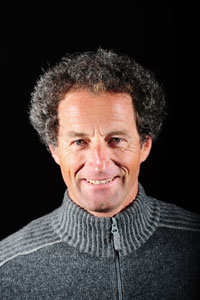
** | |Michel Desjoyeaux **|
There are many professionals sailors backed by large sponsors who are competing in this year’s Route du Rhum, but there are still a large percentage of amateur sailors as well. Would you say the spirit of the race changed?
Anybody spectator who comes to the dock to watch the start of the race can identify with and relate to amateur and lesser known sailors who have small boats. [The spectators] see that the amateur sailors do not have a lot of money but are able to live their passions.
On the other hand, the monster multihulls, which are too big and expensive for just any sailor, are interesting as well for the average fan, because these sailors are daring to do something that most spectators would never attempt to do. There is something for everyone, including the sailors and the journalists as well as the spectators, because there is a lot going on in every racing class. It is not just a question of watching to see who will be the first to arrive in Guadeloupe, but to see the fight between the competitors in each class, which can be more interesting than seeing which multihull is the first to cross the finish line.
What do the gigantic G-class multihulls of 100 feet or more, which represent a new Route du Rhum class, add to the race?
The organizers decided to bring something spectacular to this race and they made the smart decision to create the Ultimate class and to allow them to become part of the history of the Route du Rhum. Still, the race has remained true to its spirit even with these Ultimate-class boats, because the race still has smaller boats competing in other classes. At the same time, just being able to make it across the Atlantic in a huge multihull boat is much harder than crossing the ocean in a 60-foot IMOCA boat.

Stuart Streuli| |**Michel Desjoyeaux has tremendous experience and the most modern Open 60 in the fleet on his side as he competes in the 2010 Route du Rhum. Bet against him at your own risk. **|
As for myself, I like the competitive challenge of navigating a 60-foot IMOCA boat more than I do with a multihull boat, although I do still like maneuvering multihulls a lot. There is more parity between the sailors and boats in the IMOCA class, which is thus more competitive than the Ultimate category. Nobody knows who will win in the IMOCO class.
With the multihulls, weather conditions are more of a determining factor, since the boats were designed for different sea conditions. Yann Guichard’s Gitana will likely win if the weather is good while Francis Joyon’s Idec or Thomas Coville’s Sodebodo will do better if the weather is bad. In medium winds that are consistent, Franck Cammas’ Groupama 3 will likely win.
**Eric Tabarly put France on the map in long-distancing sailing with a relatively limited budget decades ago, but now France largely owes its dominance in multihull and monohull long-distance races to deep-pocketed sponsors and annual budgets that can total more than $25 million a year. What would Eric Tabarly think of the event if he were alive and racing today? **
I don’t think Tabarly would necessarily be turned off by the amount of money involved because one thing we both have in common is that he was very interested in the technology aspect of sailing and applying it to the development of better and faster boats. It is important not to forget that money is necessary if you want to invest in technology.
Why did you decide to enter the Barcelona World Race?
The start of the Barcelona World Race is six months before the start of the Vendée Globe, which is a race I like a lot and I did not want to lose my desire to compete in a race like that again, so I decided to enter the Barcelona World Race just six to eight months before the start of the Vendée Globe.
I hope the Foncia will prove to be superior to its predecessor, while I imagine that it will put up a very good fight in the Barcelona race. I will also be able to rely on the talents of my young and talented co-skipper, [27-year-old François Gabart].
**What are your thoughts about the state of the Barcelona World Race’s rules and regulations? **
More than half of the boats in the race are officially Spanish, and they thus benefit from financial incentives that are very generous. This is good for the Spanish competitors and for the world of sailing, yet we hope that aid from the Spanish government will involve more than just financial backing in the future.
Since there are two skippers, I think we will be able to push the boat farther and faster. The one thing I would change is the rules for the sails, which are limited in size and function for this type of race. I really think this could have been done differently. We only are allowed to have 10 sails, which is not enough whether for the Barcelona or other races like the Route du Rhum. It will really be a challenge to decide which sail to use and how to use them. Ten sails are really not enough.


